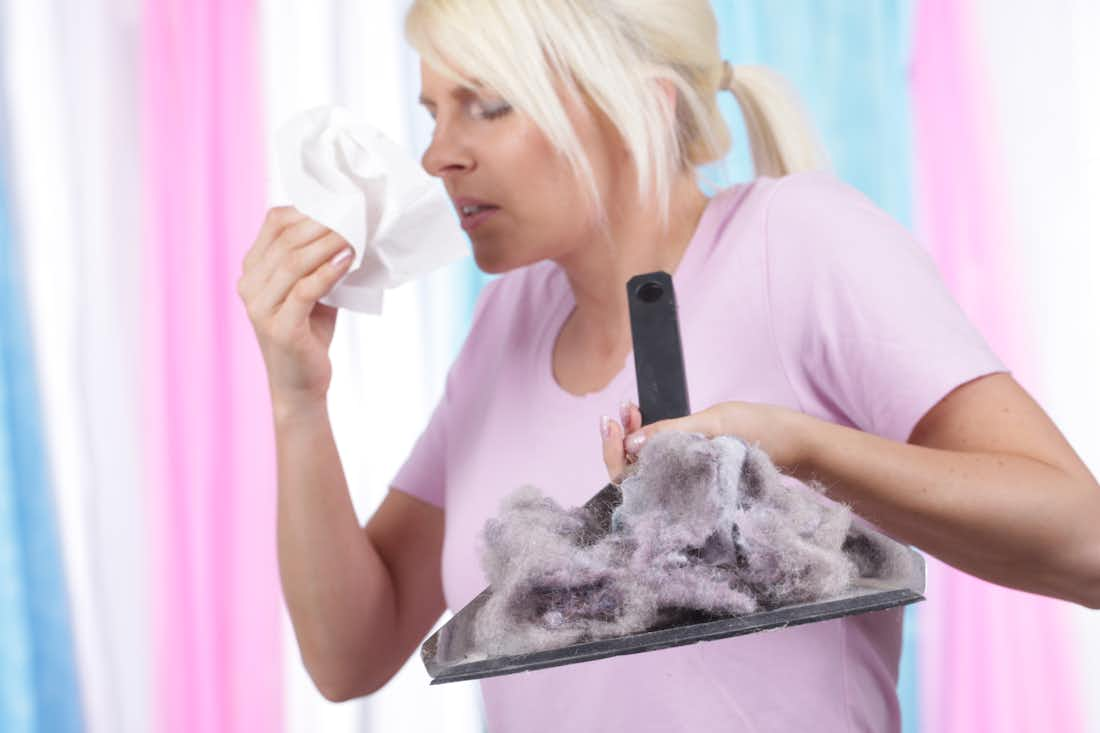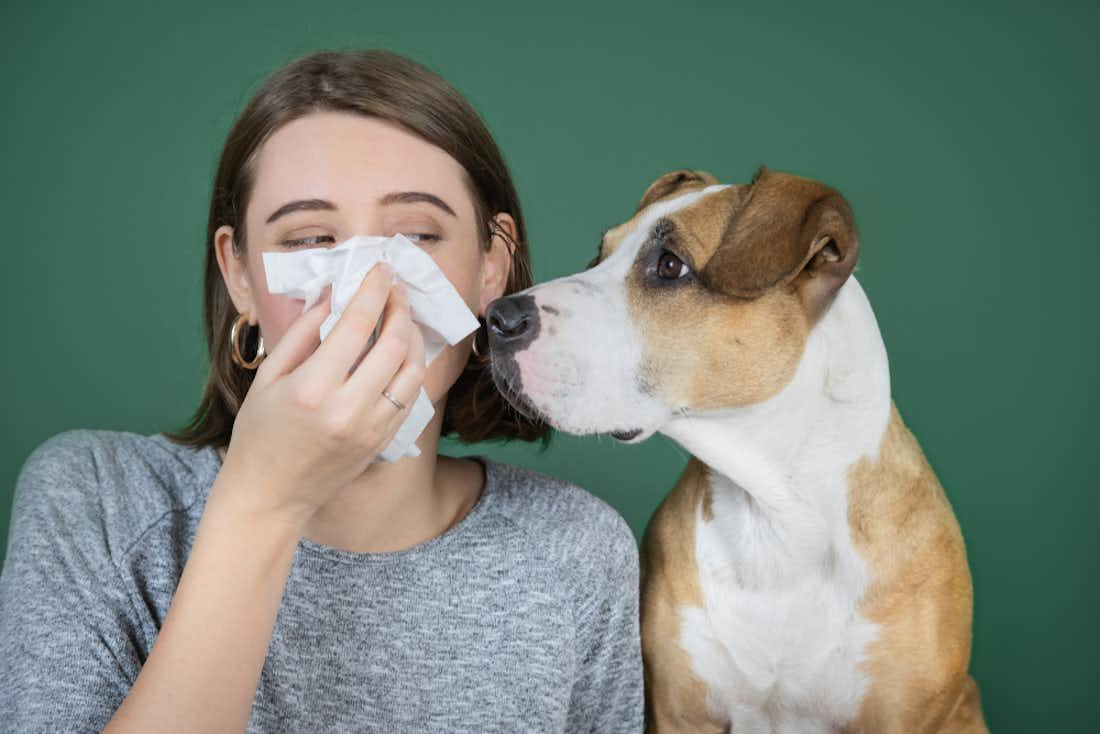Jul 12, 2022
How To Manage Your Pet Allergies
minute read
After a long, hard day of work, there’s really nothing better than walking into your home and being greeted by a furry little friend. Dogs and cats are among the most popular household pets for a reason, and it’s pretty impossible to feel sad when you’ve got one of them curled up on your lap.
With that said, your pet might be the source of many discomforts without them even realizing it. Pet dander is a common indoor allergen that can make your nose run and suck out the fun. Some other irritants you may have due to having a pet include animal fur, saliva, urine, and feces.
Before you even think about sending your pet to another loving home to alleviate your symptoms, there are plenty of options for managing your pet allergies. Here’s everything you need to know.
What Are Pet Allergies?
An allergy (allergic rhinitis) is an immune response to a harmless substance that is mistakenly perceived as dangerous. Things like pollen, dust mites, or certain foods don’t actually pose any danger to your health, though some people’s immune systems attack them as if they are.
Your dog or cat is obviously not out to harm your health (unless maybe you forget to feed them), and pet allergies occur when your body mistakenly reacts to the proteins found in animal skin cells, saliva, or urine.
Exposure to dead skin flakes is usually the main trigger, and any animal with fur can cause an allergic reaction. Though, you’re probably more likely to react to a cat than you might with a hamster.
Symptoms of pet allergies can present themselves in several ways, though it’ll likely lead to some:
- Sneezing
- Runny nose or nasal congestion
- Itchy, watery eyes
- Postnasal drip
- Cough
- Itchiness in nose or roof of the mouth
- Facial pressure
Preventing Pet Allergies
Before allowing pet dander to wreak havoc on your health and your household, there are some preventative measures you can take to alleviate some of the burdens.
For one, find out if you have a pet allergy before adopting a dog or a cat. If you’ve been around someone else’s dog or cat and noticed that it ignited many of the symptoms listed above, then you very well may have a pet allergy.
But to fully understand what you’re allergic to, as well as how severely, an allergy blood test can clear the air. Cleared’s at-home allergy testing kit scans for 40 indoor and outdoor triggers so you can know ahead of time whether or not a furry friend will become a furious fiend to your health. Plus, you can do it from the comfort of your home.
If you find out that you have a cat or dog allergy, it doesn’t mean you can’t have a pet. You can consider going with a non-furry friend, like reptiles or aquatic creatures, as an alternative.
But if that Labrador Retriever or Siberian Husky are just begging to live in your home, there are some ways you can manage your symptoms despite their frequent shedding.
Pet Allergy Remedies
If your dog or cat knew that they were causing your throat to close or your nose to drip, they’d probably be super sad.
Here are some ways to manage pet allergies:
Antihistamines
When your body is confronted with an allergy menace, it releases a chemical called histamine. Histamines are the driving force behind many allergy symptoms that make them feel so uncomfortable, like congestion, coughing, or headaches.
As their name implies, Antihistamines are medications that prohibit the production of histamines, therefore decreasing the severity of your symptoms. They’re a very quick and effective way to get some temporary relief.
Oral antihistamines, like Claritin or Zyrtec, are taken by mouth. But there are also nasal spray antihistamines that work to block the histamine in your nose and clear up congestion. Finally, eye drop antihistamines go right into your eyes to help with the itchiness and irritation that your pet’s fur might cause.
These medications are obviously pretty great… until you look at the price tag. The good news is that Cleared has generic versions of all of your favorite antihistamines for just a fraction of the price. It’s all a part of our mission to make the whole world a clearer place.
Keep Your Living Space Clean
Remember, the animal itself doesn’t really cause the pet allergy. Rather, it’s caused by their dead skin cells and fur. For that reason, it’s important to keep surfaces in your home as clean as possible to prevent dust build-up.
Vacuum carpeted and tile areas, rugs, and your furniture at least once a week to remove particles that might cause you to feel symptoms. Also, be sure to launder your bed sheets once every two weeks to remove pet dander from there as well.
If you let your pets sleep in the same bed as you, you may want to wash once a week. Curtains in main living areas can easily attract dust and pet dander, too, so be sure to throw those in the wash every so often as well.
With that in mind, you can also take some preventative measures by not allowing your pets to sit on couches or beds where you’ll spend most of your time. We understand that’s a lot easier said than done, but not only will it save you some trouble, it will also make guests feel more comfortable when they come over.
Air Purifiers and Air Conditioning
Fur and dead skin doesn’t just stick to surfaces: it also floats around in the air and easily enters your system. To help avoid floating fur from fiddling with your feelings, you can use an air purifier.
Air purifiers, or high-efficiency particulate air cleaners (HEPA), help to remove harmful substances from the air like viruses, bacteria, allergens, odors, mold, and chemicals so you can breathe cleaner air. Having a HEPA air cleaner can enhance your home's air quality. Place them in rooms where you and your pets spend a lot of time, like the bedroom or living room.
Also, consider changing your air filter when it's due. Having a clean air conditioning filter can go a long way to keep the air around you clean.
If you don’t have an air purifier, running the air conditioner can do the trick as well. This will help circulate cleaner air into your home while also keeping the humidity more comfortable. This will also help limit the risk of your living space developing mold spores, another common indoor allergen.
Bath Time
If there’s one thing that dogs and cats can both agree on, it’s that they don’t love taking baths. And as the owner, giving them might be even more of a hassle. With that said, bathing your animal might be a necessary evil if you want to cut back on allergen exposure in your home.
Bathing your furry friend at least once a week can help remove dead skin cells before they get the chance to stick to other surfaces in your home. You can even buy special hypoallergenic shampoos to reduce their shedding in the future.
Immunotherapy
Petting a dog is one of the finer things in life. Sneezing for the rest of the day is not. The good news is that you might be able to reduce your symptoms for good with an allergy immunotherapy treatment.
Allergy immunotherapy, or AIT, works by gradually exposing you to an allergen over time so that your immune system can adjust. It’s like running another .1 miles every day until you’re finally running a full marathon with ease.
This is a treatment that requires a prescription from a doctor. Luckily, your online allergist is in and can help guide you in the right direction towards lifelong relief.
Cleared Can Help Your Pet Allergies
Pet allergies are a small price to pay for the love and joy that a furry friend can bring. But if you’re reading this article, know that you’re making a much better decision than deciding to send your pet off to a new home.
You can manage your symptoms with antihistamine medications or even allergy immunotherapy treatments. But sometimes, all it takes is some extra cleaning, like vacuuming your linens or bathing your animals more frequently.
Not to mention, other common indoor triggers might be causing you discomfort other than your pet -- so don’t jump to any conclusions. Dust mites, mold, and seasonal pollen allergies present themselves with the same symptoms.
Cleared is your one-stop allergy shop for the best treatment, regardless of your symptoms, to get personalized treatment from home from US-licensed allergy doctors. With personalized therapy and FDA-approved over-the-counter medications, you’ll never need to go to the allergy clinic again.
Sources:
Pet allergy - symptoms and causes | The Mayo Clinic
Allergies: Types, Symptoms, Causes & Treatments | Cleveland Clinic
Antihistamines: Definition, Types & Side Effects | Cleveland Clinic
Authors

Dr. Payel Gupta
Medically reviewed by Dr. Payel Gupta



